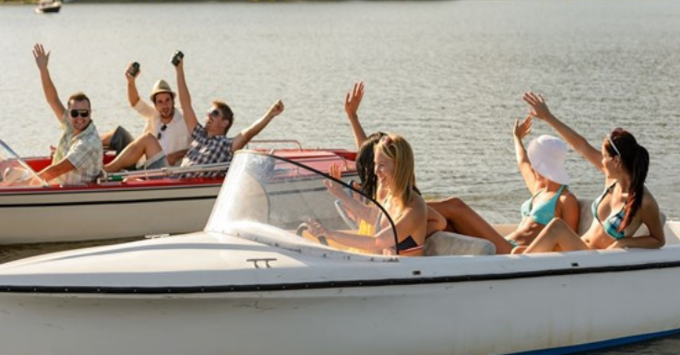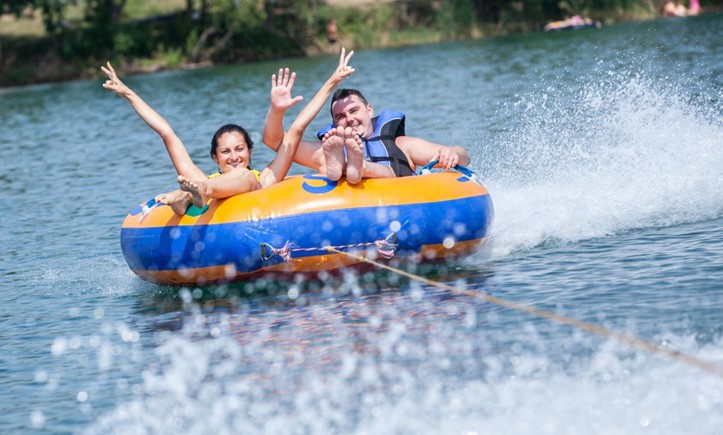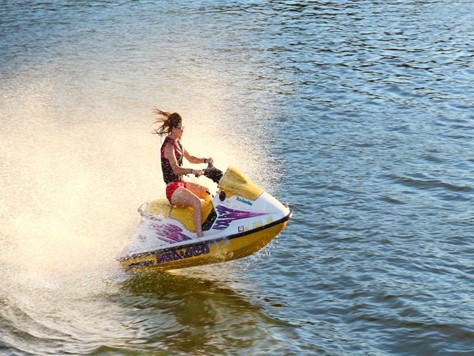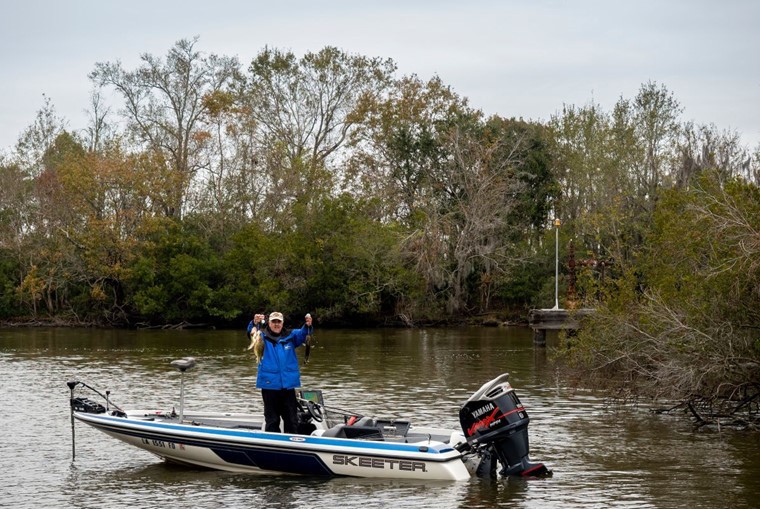
Am I Civilly Liable for Property Damage, Death or Injury Occurring on the Water Near my Waterfront Property?
As our waterfront law team travels around the Commonwealth assisting clients and teaching other lawyers about riparian rights, one question that we are frequently asked is whether a waterfront property owner is civilly liable if a person is injured or killed in the waterways on or adjacent to his property. Consider, for example, the situation where a fast moving jet ski runs into a pier. The same question applies when there is property damage in the waterway near a person’s property, such as might happen if a vessel strikes a submerged object, takes on water, and sinks. These are excellent questions, and the answer, like many things in the law, is “it depends.” One of the big reasons why this can get so complicated is due to the interplay between Virginia law (i.e. tort law) and Federal law (i.e. admiralty and maritime law).
There are of course other types of more exotic cases that sometimes come up when, for example, there is an environmental spill in a waterway. We wrote this article keeping in mind the garden variety type of property damage, personal injury, or death situation. Read Legal Remedies for damages By 94,000 Gallons Of Aviation Fuel Released At Naval Air Station Oceana, Environmental Law: An Oil Spill Could Cost Your Business, or Oil Spills: The Clean Water Act to the Oil Pollution Act of 1990 to learn about how things work if there is an oil or hazardous substance spill on the waterway.

(Petrenko Andriy / shutterstock.com)
The State Law of Virginia Regarding Injuries Near Your Waterfront Property
Let’s get started by taking a look at how things work under Virginia law. The broad family of law that we are talking about here is called “tort” law. The two branches of tort law that will typically come into play in most situations are the legal doctrine in tort law known as “premises liability” and the legal doctrine in tort law known as “negligence." The premises liability doctrine applies when the person alleged to have caused the property damage, injury or death also owns the bottomland at the accident site. The negligence doctrine applies in all of the other situations.
Premises Liability for Injury or Death on the Water Under Virginia Law
This legal doctrine applies only if the person alleged to have caused the property damage, injury or death also owns the bottomland underneath the water.
In most cases, waterfront property owners do not own the land under the waterbodies that abut their properties. As per Virginia Code § 28.2-1200 that land, known as “bottomland,” is owned by the Commonwealth and held in trust for the people. Virginia Code states as follows:
All the beds of the bays, rivers, creeks and the shores of the sea within the jurisdiction of the Commonwealth, not conveyed by special grant or compact according to law, shall remain the property of the Commonwealth and may be used as a common by all the people of the Commonwealth for the purpose of fishing, fowling, hunting, and taking and catching oysters and other shellfish. No grant shall be issued by the Librarian of Virginia to pass any estate or interest of the Commonwealth in any natural oyster bed, rock, or shoal, whether or not it ebbs bare.
Therefore, in the majority of cases wherein the property is located on a bay, river, creek, or on the coastline, the bottomland -- like the water over it -- is owned by the Commonwealth and held in trust for the public who are free to boat and fish in those waters. While these waterfront property owners have a “riparian area” in the water in which they enjoy certain exclusive rights, they do not actually own the water or the land beneath it. Please reference our Riparian Rights Explained article for a thorough explanation of these exclusive riparian rights and if you would like a full description of the method for determining the size and location of the riparian area, read our Riparian Rights For Establishing A Riparian Area Under Virginia Law article. Therefore in most cases property owners do not have legal exposure under the “premises liability” doctrine in Virginia tort law for property damage or injuries which occur in the water adjacent to their properties, because the premises is owned by the state and not the private landowner.
However, there are a few rare exceptions in which a private party may own bottomland under a bay, river or seashore. For example, a landowner can own the bottomland if she has a “King’s Grant.” This occurs when a landowner can trace his/her chain of title all the way back to colonial times and is able to show that the bottomland was conveyed by the Crown to a previous owner in the chain. This possibility is explicitly accounted for in Va. Code 28.2-1200, which refers to, “All the beds of the bays, rivers, creeks and the shores of the sea within the jurisdiction of the Commonwealth, not conveyed by special grant . . . (emphasis added).”
Along those same lines, prior to 2007 the Commonwealth had the power to convey bottomland to private parties. This ended with the enactment of Va. Code §28.2-1200.1 which prohibits the conveyance of state-owned bottomland. If a landowner received a conveyance of bottomland from the Commonwealth prior to enactment of that statute, s/he retains ownership. If a riparian property owner does own bottomland of a navigable waterway such as a bay or large river through one of these exceptions to the general rule, he could have liability to injured persons under both federal law as explained above, and under state law premises liability as will be further explained in this article.
Furthermore, there are certain bodies of water which are excluded from §28.2-1200 and the bottomland of these waterbodies can be, and often is, privately owned. These include ponds, lakes, and non-navigable streams. Another possibility is when a property owner excavates part of her land and it fills with water, in which case she retains ownership of the bottomland. There are any number of residential subdivisions where the developer excavated land to create a canal that would connect the lots in the subdivision to an adjoining river. The bottomland in these canals is privately owned.
In those situations where the premises liability doctrine would apply (i.e. the person alleged to have caused the property damage, injury or death also owns the bottomland underneath the water), most commonly at ponds, lakes and non-navigable streams, Virginia law on premises liability focuses on the category of the person who owns or operated the property (in a property damage case) and, in an injury or death case, the court will focus on the category of the injured or deceased person. There are three categories of potential plaintiffs, briefly summarized as follows:
Trespasser: The landowner is shielded from liability. The seminal case on this point is Washabaugh v. N. Va. Const. Co., 187 Va. 767, 48 S.E.2d 276 (1948), in which the Supreme Court of Virginia found that the owners of a quarry were not responsible for a child drowning on the premises. The owners were not under a duty to put up a fence, or warning signs, or otherwise take steps to keep trespassers out. This was true even though the owners were aware that children sometimes swam in the quarry.
This is the situation that would apply if someone were to come onto a person’s land and swim in his pond, for example, without permission. That person would be a trespasser, and the landowner would not be liable for their injuries.
Licensee: This refers to someone on the waterbody with the landowner’s permission, such as a social guest. In this situation the landowner only has liability if he knows of a particular non-obvious danger and fails to warn the licensee of the condition.
As an example, imagine that the landowner is aware of strong currents occurring under the surface of the water in his pond. If that landowner were to invite guests to his house to swim in the pond and fails to warn them of the hidden danger, he could potentially be liable for their injuries. Of note, this only applies if the owner were actually aware of the danger, which of course the plaintiff would have to prove. The landowner is not required to seek out all potential dangers before allowing guests to swim in his pond.
Invitee: This refers to a situation in which the premises is open to the general public for a particular reason, such as swimming or boating, and the Plaintiff is injured on the premises during the course of that activity. For example, this may occur when someone owns a swimming resort and allows the public to use the facility for swimming. In that situation the owner has a higher duty of care to the invitees and potentially more significant civil liability.
For example, in Blacka v. James, 205 Va. 646, 139 S.E.2d 47 (1964) a decedent child’s estate sued the owner of a swimming resort and lake for failure to have an appropriate number of lifeguards and failure to have appropriate warning signs and safety appliances. The swimming resort was a business which was open to the public. The Trial Court entered judgment for the Plaintiff on the issue of the lifeguards. The Virginia Supreme Court, in a case of first impression, stated the law as follows: “The general rule is that the owner of a swimming pool or lake to which the general public is invited for a consideration must exercise ordinary care for the safety of his patrons. He must make reasonable provisions to guard against those accidents which common knowledge and experience teach are likely to befall those engaged in swimming and other aquatic sports for which he has provided facilities, but the owner is not an insurer of the safety of his patrons.” Id. at 649.
Significantly, in order to be successful the Plaintiff must also show that the negligence was the proximate cause of the drowning. As the Court put it, “[T]he mere fact that a person has drowned in a swimming pool or lake, even though the owner and operator is negligent in not using reasonable care to protect his patrons, does not, without more, establish the liability of a defendant. The negligence of the defendant must have a causal connection with the drowning, and in the absence of a showing that a defendant's negligence was the proximate cause of the death there can be no recovery.” Id. at 650. Finding that there was no indication that the presence of lifeguards would have saved the boy, the Court held that there was no causal connection between any act or omission by the swimming resort which proximately caused the drowning death. Thus it reversed the Trial Court and entered judgment for the Defendant.
In Piggott v. United States, 480 F.2d 138 (4th Cir. 1973) the Plaintiff drowned at a government-owned beach and the estate brought suit claiming that there had been an inadequate number of lifeguards. The Eastern District of Virginia found for the government, relying on Washabaugh, and holding that the government had no duty to the swimmers. The Fourth Circuit reversed and remanded for a new trial. It distinguished Washabaugh, quoting the Blacka v. James language about a higher duty to invitees at waterbodies. They remanded the case to be tried under the standard of an invitee, but pointed out that even if the government was found to have provided inadequate precautions, the Plaintiff would still have to prove causation in order to recover.
In Volpe v. City of Lexington, 281 Va. 630, 708 S.E.2d 824 (2011) the City of Lexington owned and operated a riverside park open to the public for swimming. There was a dam on the premises, and the decedent drowned in the vicinity of the dam. The Trial Court held that the City had no duty to warn the swimmers because the danger posed by the dam was open and obvious. The Supreme Court reversed, finding that the swimmers were invitees and the City had a duty to warn of the danger posed by particularly dangerous hydraulic forces under the water’s surface in the vicinity of the dam, which was known to the City but not apparent from common observation.
To sum up, the more common situation where the waterfront property owner likewise owns the bottomland comes about at lakes, ponds, non-navigable streams, and in man-made canals. In these situations, the premises liability doctrine under Virginia law will control whether you are liable for property damage, injury or death that occurs on these waters.

(DCornelius / Shutterstock.com)
Negligence Liability for Property Damage, Injury or Death on the Water Under Virginia Law
The negligence legal doctrine will apply if the property damage, injury or death takes place in waters with bottomland that is owned by someone other than the person who is alleged to have caused the harm. The venerable 144 year old case of City of Petersburg v. Applegarth's Adm'R, 69 Va. 321 (1877) offers one such example.
In the City of Petersburg, a vessel carrying coal struck a submerged object (a pile) at the bottom of a river, which punched a hole in the hull of the vessel after which it took on water and sank. The vessel owner successfully sued the adjacent waterfront property owner because, in the words of the Court, “It is negligence to permit anything to project from the side of a wharf in such manner as, by any probable combination of circumstances, to endanger the safety of vessels moored to the wharf.”

(Victor Wong / Shutterstock.com)
The Federal Admiralty and Maritime Law
But escaping exposure under Virginia state law does not mean that a waterfront property owner is completely absolved of all potential liability because liability can attach through application of the admiralty and maritime law of the United States, which arises under federal law. Under Article III, Section 2 of the United States Constitution, the federal courts have jurisdiction over admiralty and maritime matters. It is clear that the admiralty and maritime law of the United States applies in the open ocean. But we need to look at court decisions to see whether the admiralty and maritime jurisdiction reaches into inland waters such as lakes, ponds, or inland rivers or streams.
Fortunately, the United States Supreme Court has provided some clarity in a series of decisions on this topic. The Court has outlined a two-part test. If both parts of the test are met, there is a cause of action under federal law. To meet the test, the incident must have occurred both (1) in navigable waters, and (2) there must be some connection between the incident and maritime activity. See Executive Jet Aviation, Inc. v. Cleveland, 409 U.S. 249, S. Ct. 493 (1972); and Foremost Ins. Co. v. Richardson, 457 U.S. 668, 102 S. Ct. 2654 (1982).
The first part of the test requires that the incident take place in “navigable waters.” This is called the “locality test” because it refers to the location in which the incident took place. The Court has determined that “navigable waters” are those which are tidal, and/or which may be used in interstate commerce. The second part of the test is called the “nexus test” because it requires some connection (or nexus) between the incident in question and maritime activity. To satisfy the nexus test, the Plaintiff must show both that the incident has a potentially disruptive impact on maritime commerce and that the activity giving rise to the incident has a substantial relationship to traditional maritime activity.
So how could a riparian property owner face liability under admiralty and maritime law for an accident occurring in his riparian area, which he does not own, under this standard? Here is one potential example. One of the most important riparian rights is the right to build a pier out to navigable waters. This is the reason that many people purchase waterfront property, and pay a significant premium for it. For an explanation of pier rights and how to build a pier in Virginia, reference our How To Build A Pier In Virginia? Waterfront Property Rights Explained article.
As that article explains in detail, several permits are required in order to construct a pier. One such permit is issued by the U.S. Army Corps of Engineers. Under the federal Rivers and Harbors Act, the Army Corps is charged with ensuring safe navigation in the waters of the United States. Before issuing a permit for a pier, the Army Corps must determine that the location and/or size of the proposed pier does not pose a hazard to boaters in the area.
Imagine that a commercial fishing vessel, on a dark night, has a collision with a pier located in the Chesapeake Bay. If a riparian property owner has complied with all of the permit requirements in the construction of the pier, including the requirement to obtain approval from the Army Corps of Engineers, there is a presumption that the pier is not a hazard to navigation and the riparian owner will most likely be insulated from liability. However, if the pier was not properly permitted, it will be presumed that the pier is a hazard to navigation and the riparian owner may face severe civil liability.
Although there would be no premises liability under state law because the riparian owner does not own the water or the land under it, this situation would seem to meet the test for federal maritime and admiralty jurisdiction. The Chesapeake Bay is clearly a navigable waterway, so the “locality test” is met. Furthermore, the operation of a commercial fishing boat could have a disruptive impact on maritime commerce and does have a substantial relationship to maritime activity. Therefore, the owner of the fishing vessel probably has a cause of action against the pier owner under federal maritime and admiralty law. The “Savings to Suitors Clause” in Title 28 of the U.S. Code allows the owner to bring suit either in the federal court system or in the state court system which will apply federal law. 28 USC §1333.
Now imagine the same scenario, but rather than a commercial fishing vessel, it’s a recreational jet ski that hits the pier. It seems unlikely that the Plaintiff would be able to prove that a jet ski has a substantial relationship to maritime commerce under the nexus test, so he probably would not be able to successfully bring suit under federal law.
Conclusion
Liability for property damage, injuries or death sustained on waterbodies is complex, with aspects of both state tort law and federal admiralty and maritime law. If you have a question regarding property damage, injury or death near a waterbody, contact our team and we will find the answer.
